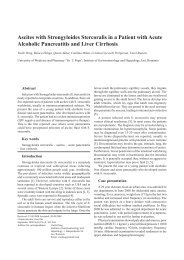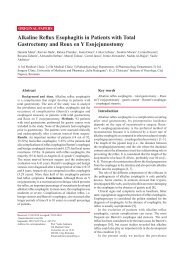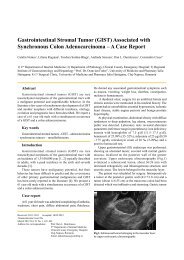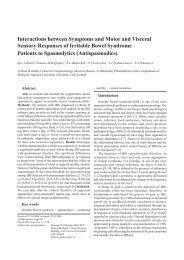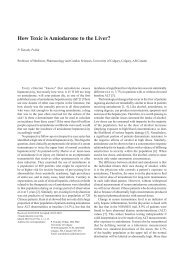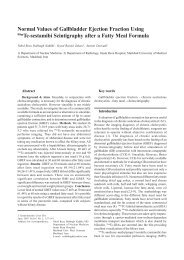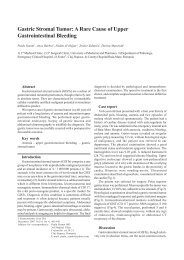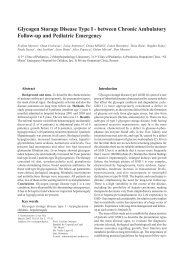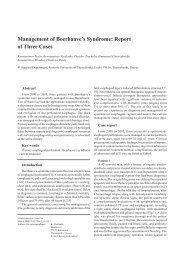Adverse Drug Reactions in Clinical Practice - Journal of ...
Adverse Drug Reactions in Clinical Practice - Journal of ...
Adverse Drug Reactions in Clinical Practice - Journal of ...
You also want an ePaper? Increase the reach of your titles
YUMPU automatically turns print PDFs into web optimized ePapers that Google loves.
354<br />
Def<strong>in</strong>itions and classification <strong>of</strong> ADRs<br />
An adverse drug event or experience is def<strong>in</strong>ed as<br />
‘any untoward medical occurrence that may present<br />
dur<strong>in</strong>g treatment with a medic<strong>in</strong>e but which does not<br />
necessarily have a causal relationship with this treatment’.<br />
An adverse event is an adverse outcome that occurs while<br />
a patient is tak<strong>in</strong>g a drug, but is not or not necessarily<br />
attributable to it. This dist<strong>in</strong>ction is important, for<br />
example, <strong>in</strong> cl<strong>in</strong>ical trials <strong>in</strong> which not all events are<br />
drug-related. When this term is used to describe adverse<br />
outcomes, physicians should be aware that it is not always<br />
possible to impute causality [8, 9].<br />
An adverse drug reaction (ADR) is ‘a response to a<br />
medic<strong>in</strong>e which is noxious and un<strong>in</strong>tended, and which<br />
occurs at doses normally used <strong>in</strong> man for the prophylaxis,<br />
diagnosis, or therapy <strong>of</strong> disease or for the modification<br />
<strong>of</strong> a physiological function’. An ADR, contrary to an<br />
adverse event is characterised by the suspicion <strong>of</strong> a causal<br />
relationship between the drug and the occurrence. This<br />
def<strong>in</strong>ition underl<strong>in</strong>es the fact that the phenomenon is noxious<br />
(differentiat<strong>in</strong>g adverse drug reaction from side-effects<br />
which can also be beneficial) and that it <strong>in</strong>cludes doses<br />
prescribed cl<strong>in</strong>ically, exclud<strong>in</strong>g accidental or deliberate<br />
overdose [8, 10].<br />
An unexpected adverse reaction is ‘an adverse reaction,<br />
the nature or severity <strong>of</strong> which is not consistent with<br />
domestic labell<strong>in</strong>g or market authorisation or expected from<br />
characteristics <strong>of</strong> the drug’ [11].<br />
A side effect is ‘any un<strong>in</strong>tended effect <strong>of</strong> a pharmaceutical<br />
product occurr<strong>in</strong>g at doses normally used by a patient,<br />
which is related to the pharmacological properties <strong>of</strong> the<br />
drug’. This def<strong>in</strong>ition was formulated to <strong>in</strong>clude side effects<br />
that, although are not the ma<strong>in</strong> aim <strong>of</strong> the therapy, may be<br />
beneficial rather than harmful. For example a β-blocker agent<br />
used to treat hypertension may, by β-blockade, also relieve<br />
the patient’s ang<strong>in</strong>a [9, 11].<br />
A serious adverse event (experience) or reaction is any<br />
untoward medical occurrence that at any dose results <strong>in</strong><br />
death; is life-threaten<strong>in</strong>g; requires <strong>in</strong>patient hospitalization or<br />
prolongation <strong>of</strong> exist<strong>in</strong>g hospitalization; results <strong>in</strong> persistent<br />
or significant disability/<strong>in</strong>capacity, or is a congenital<br />
anomaly/birth defect.<br />
There is a difference between the terms “serious” and<br />
“severe”, which are not synonymous. The term “severe” is<br />
used to describe <strong>in</strong>tensity (severity) <strong>of</strong> an event (as <strong>in</strong> mild,<br />
moderate or severe). The event itself can be <strong>of</strong> relatively<br />
m<strong>in</strong>or medical significance, such as a severe headache. This<br />
is not the same as the “serious” which is based on the patient<br />
and event outcome [8].<br />
The most common classification <strong>of</strong> ADRs is the one<br />
that dist<strong>in</strong>guishes dose-related (type A – augmented effects<br />
<strong>of</strong> the drug action) and non-dose-related (type B – bizarre<br />
reactions) adverse drug reactions. There are other groups <strong>in</strong><br />
this system <strong>of</strong> classification but these may also be considered<br />
as subclasses or hybrids <strong>of</strong> type A and B ADRs. These are<br />
type C ADRs (chronic reactions, dose- and time-related),<br />
Farcas et al<br />
type D (delayed reactions, time-related), type E (end <strong>of</strong><br />
use reactions) and type F (failure <strong>of</strong> therapy) [9, 12]. The<br />
characteristics, some examples and the management <strong>of</strong><br />
these ADRs are listed <strong>in</strong> Table I [9, 13-18]. An alternative<br />
classification system proposes only 3 major groups <strong>of</strong><br />
adverse reactions, referred as type A (drug actions), type B<br />
(patient reactions) and type C (statistical effects) adverse<br />
drug reactions [13[.<br />
ADRs’ diagnosis and causality assessment<br />
It might be difficult to establish a cl<strong>in</strong>ical diagnosis <strong>of</strong><br />
drug-<strong>in</strong>duced disease as ADRs tend to mimic any natural<br />
occurr<strong>in</strong>g disease process. Few drugs produce dist<strong>in</strong>ctive<br />
and specific physical signs that can be considered without<br />
any doubt ADRs (e.g. extrapyramidal disorders). In any<br />
case, if the patient is tak<strong>in</strong>g drugs, a differential diagnosis<br />
should consider the probability <strong>of</strong> an ADR. Several years<br />
ago Irey described, <strong>in</strong> a very comprehensive manner, the<br />
diagnostic problems that might <strong>in</strong>terfere <strong>in</strong> the evaluation <strong>of</strong><br />
an ADR and proposed a methodology that is still valid and<br />
applicable. When assess<strong>in</strong>g the probability <strong>of</strong> a suspected<br />
ADR, the cl<strong>in</strong>ician should always evaluate the follow<strong>in</strong>g<br />
aspects: temporal relationship between the use <strong>of</strong> the drug<br />
and the occurrence <strong>of</strong> the reaction (time to onset), the<br />
differential diagnosis (<strong>of</strong> causes other than the suspected<br />
drug), the selection <strong>of</strong> the responsible drug on the basis<br />
<strong>of</strong> pattern <strong>of</strong> the event or by exclusion, dechallenge and<br />
rechallenge. The pattern <strong>of</strong> the adverse event must fit<br />
the known pharmacology or allergy pattern <strong>of</strong> one <strong>of</strong> the<br />
suspected drugs or <strong>of</strong> chemically or pharmacological related<br />
compounds. Detailed <strong>in</strong>formation on all these aspects that<br />
must be considered when evaluat<strong>in</strong>g an ADR is presented<br />
<strong>in</strong> Panel 1 [9, 15, 19].<br />
When evaluat<strong>in</strong>g an ADR, one must take <strong>in</strong>to consideration<br />
the factors that can predispose patients to adverse reactions.<br />
Some ADRs are associated with specific patient and/or drugrelated<br />
factors. These factors are presented <strong>in</strong> Table II. Among<br />
these factors, the pharmacok<strong>in</strong>etic and pharmacodynamic<br />
pr<strong>of</strong>ile <strong>of</strong> a drug might be <strong>in</strong>fluenced by disease pathology,<br />
physiologic status, concomitant therapy and lifestyle.<br />
For example, excessively high or low concentrations <strong>of</strong> a<br />
drug at the site <strong>of</strong> action may occur as a result <strong>of</strong> altered<br />
pharmacok<strong>in</strong>etic <strong>of</strong> the drug (e.g. metabolism, excretion).<br />
Concurrent diseases such as renal impairment will lead to<br />
drug toxicity for drugs or drug metabolites that are highly<br />
dependent on the kidney for removal, if the dose <strong>of</strong> the drug<br />
is not properly adjusted. Likewise, doses <strong>of</strong> the drugs that<br />
undergo hepatic metabolism may also produce toxicity <strong>in</strong><br />
patients with severe hepatic disease, particularly cirrhosis.<br />
Cardiovascular disease such as congestive heart failure may<br />
also reduce hepatic blood flow and decrease the clearance<br />
<strong>of</strong> certa<strong>in</strong> drugs [20].<br />
<strong>Drug</strong>-drug <strong>in</strong>teractions contribute to a significant number<br />
<strong>of</strong> ADRs, especially <strong>in</strong> elderly patients and <strong>in</strong> patients that are<br />
under polymedication. There is an exponential relationship<br />
between the number <strong>of</strong> drugs taken and the probability <strong>of</strong> an




